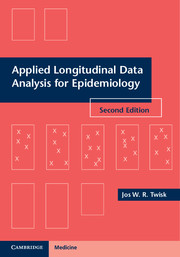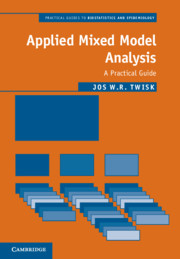Applied Longitudinal Data Analysis for Epidemiology
This book discusses the most important techniques available for longitudinal data analysis, from simple techniques such as the paired t-test and summary statistics, to more sophisticated ones such as generalized estimating of equations and mixed model analysis. A distinction is made between longitudinal analysis with continuous, dichotomous and categorical outcome variables. The emphasis of the discussion lies in the interpretation and comparison of the results of the different techniques. The second edition includes new chapters on the role of the time variable and presents new features of longitudinal data analysis. Explanations have been clarified where necessary and several chapters have been completely rewritten. The analysis of data from experimental studies and the problem of missing data in longitudinal studies are discussed. Finally, an extensive overview and comparison of different software packages is provided. This practical guide is essential for non-statisticians and researchers working with longitudinal data from epidemiological and clinical studies.
- New chapters discuss the role of the time variable and new features of longitudinal data analysis
- An extensive overview and comparison of different software packages helps users to determine which is most appropriate for their needs
- The text is supplemented with figures and examples of computer software outputs to aid reader understanding of the techniques presented
Reviews & endorsements
Review of the first edition: 'Overall, the book is well written, and the material is rich and carefully organised … the book is a welcome reference manual or practical guide for practitioners of statistical methods in (but not limited to) epidemiological and clinical studies. The book's main value is in its rather comprehensive presentation of a collection of longitudinal data analyses arising from different research questions. In this sense, the book is unique. Some practitioners of statistics may have struggled to learn longitudinal data analysis by reading manuals of software packages. This book is potentially of great benefit to them.' Journal of the American Statistical Association
Product details
June 2013Hardback
9781107030039
336 pages
253 × 178 × 20 mm
0.8kg
60 b/w illus. 212 tables
Temporarily unavailable - available from TBC
Table of Contents
- Preface
- Acknowledgements
- 1. Introduction
- 2. Study design
- 3. Continuous outcome variables
- 4. Continuous outcome variables - relationships with other variables
- 5. The modelling of time
- 6. Other possibilities for modelling longitudinal data
- 7. Dichotomous outcome variables
- 8. Categorical and 'count' outcome variables
- 9. Analysis data from experimental studies
- 10. Missing data in longitudinal studies
- 11. Sample size calculations
- 12. Software for longitudinal data analysis
- 13. One step further
- References
- Index.









